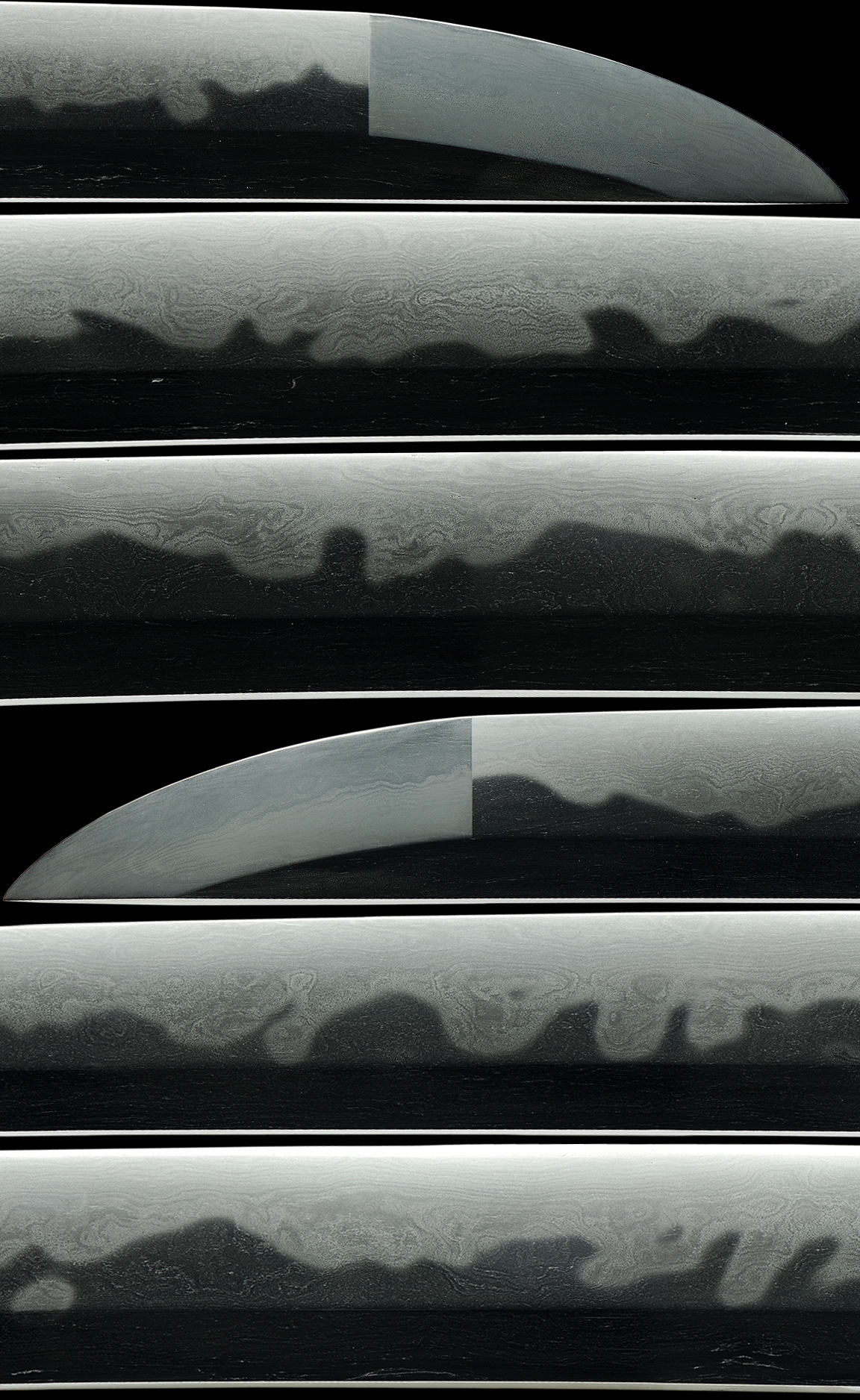A beautiful Shinshinto Katana, this sword is reminiscent of much earlier Soshu style work. At first glance this blade reminds one of the majestic blades of the finest Soshu Den smiths. A long, wide sword attributed to Kunihide with a extremely active and swirling hamon. Even the hamon shows hamon hada or a grain pattern within the yakiba. At 29-1/2 ” this blade is an incredible one of a kind piece. The hada is incredibly clear and visible and appears to be a Masame with itame, there is masame nagare . There is a longish wavy kissaki and very active. There is ji nie all over. The hamon is a large notare gunome and truly spectacular which is in a pristine polish. A fantastic sword with much to enjoy and appreciate. The hamon has a 3d like appearance with almost every activity that is imaginable. You can find kinsugi, sunagashi, ashi, yo and chikei can be found in the hada. The kissaki is a long O-kissaki with a very active boshi filled with sunagashi.
About the smith:
KUNIHIDE (国秀), Tenpō (天保, 1830-1844), Kōzuke – “Jōshū Annaka-jū Enryūshi Tachibana Kunihide” (上州安中住円龍子橘国秀), “Tachibana Enryūshi Kunihide saku” (立花円龍子国秀作), “Sōshū Kamakura-jū Tachibana Kunihide” (相州鎌倉住橘国秀), “Enryūshi Kunihide saku” (円龍子国秀作), real name Tachibana Hayato (橘隼人), student of Ikkansai Yoshihiro (一貫斎義弘), he worked for the Annaka fief (安中藩) of Kōzuke province, during the Tenpō he worked temporarily also in Echigo, between Kaei (嘉永, 1848-1854) and Bunkyū (文久, 1861-1864) he moved eventually to Kamakura, most of his blades have a magnificent sugata with a wide mihaba and an elongated kissaki, the jigane is an ō-itame or masame, the hamon is a notare mixed with gunome and sunagashi, the bōshi is midare-komi, he signed his family name Tachibana with (橘) and (立花), the character “En” (円) of his gō Enryūshi is chiselled in the old style (圓)
About the mounts:
These are original to the blade, the saya and tsuka have been professionally restored adding to the overall feel and elegance to this Katana. The original abalone saya has been restored to its original beauty. The fittings are in solid iron and not meant to be fancy. Instead they have a more real swordsmen feel to them. The fuchi/kashira are tried with silver that matches the Habaki. The tsuba is signed “Nobuie” a famous signature as this line of tsuba makers was well known. The tsuba would have to be researched more to be sure but it is a strong well designed tsuba. The menuki are of koto and fans that are associated to Geisha and relaxing moments for a samurai. The habaki is finished in silver with a rain cloud motif that has great depth.
This is more than just a good sword but a fine work of art that even a novice can appreciate and truly cherish for years to come.
- Mei: Mumei Attributed to “Tachibana Kunihide”
- Date: Late Edo
- Nagasa: 29-1/2 inches
- Sori: 15.0 mm
- Width at the ha-machi: 33.5 mm
- Width at the yokote: 25.9 mm
- Thickness at the mune-machi: 6.5 mm
- Construction: Shinogi zukuri
- Mune: Iori
- Nakago: Ubu
- Kitae: Itame/masame
- Hamon: Midare Gunome
- Boshi: sugu with a ko-maru-kaeri
- Condition: Excellent Sashikomi polish
Email us if your interested in this item and remember to include the order number for this item: fss-738.
kantei-sho (鑑定書) – Appraisal
Den, Enryûshi Kunihide (伝円竜子国秀)
shôshin (正真) – Authentic
nagasa 2 shaku 4 sun 7 bu kore ari (長さ弐尺四寸七分有之) – Blade length ~ 74.8 cm
Heisei 27 nen 5 gatsu 17 nichi (平成二十四年二月十日) – February 2nd 2012
Nihon Tôken Hozon Kai (日本刀剣保存会) – NTHK
No 17,683
meibun (銘文) – Signature: mumei
kitae (鍛) – Forging: itame
hamon (刃紋) – Hardening: gunome-midare
bôshi (鋩子) – Hardening in tip: sugu with a ko-maru-kaeri
chôkoku (彫刻) – Engravings:
nakago (中心) – Tang: mekugi-ana (目釘穴) 1, yasurime (鑢): kiri
bikô (備考) – Remarks: Kôzuke povince, around Tenpô (天保, 1830-1844)
shinsa’in natsu’in (審査員捺印) – Seals of Judges: 4 seals
For Sale

























